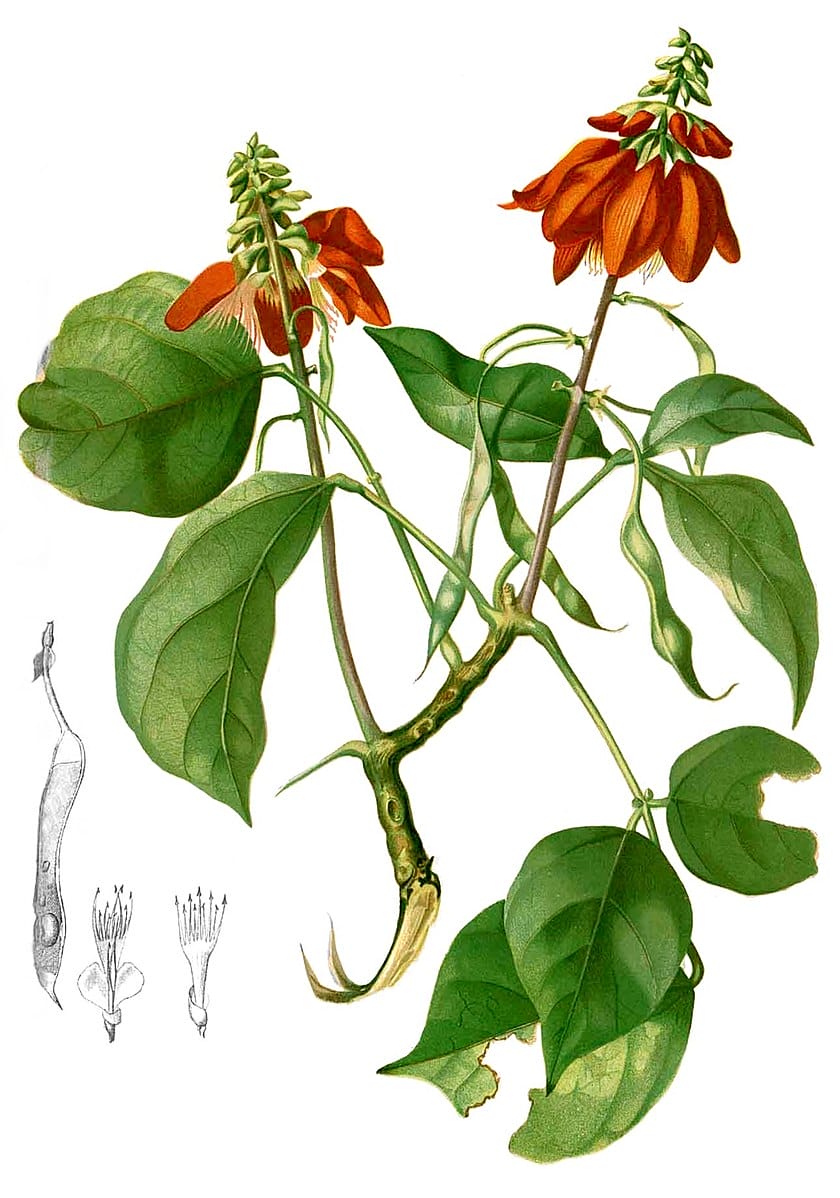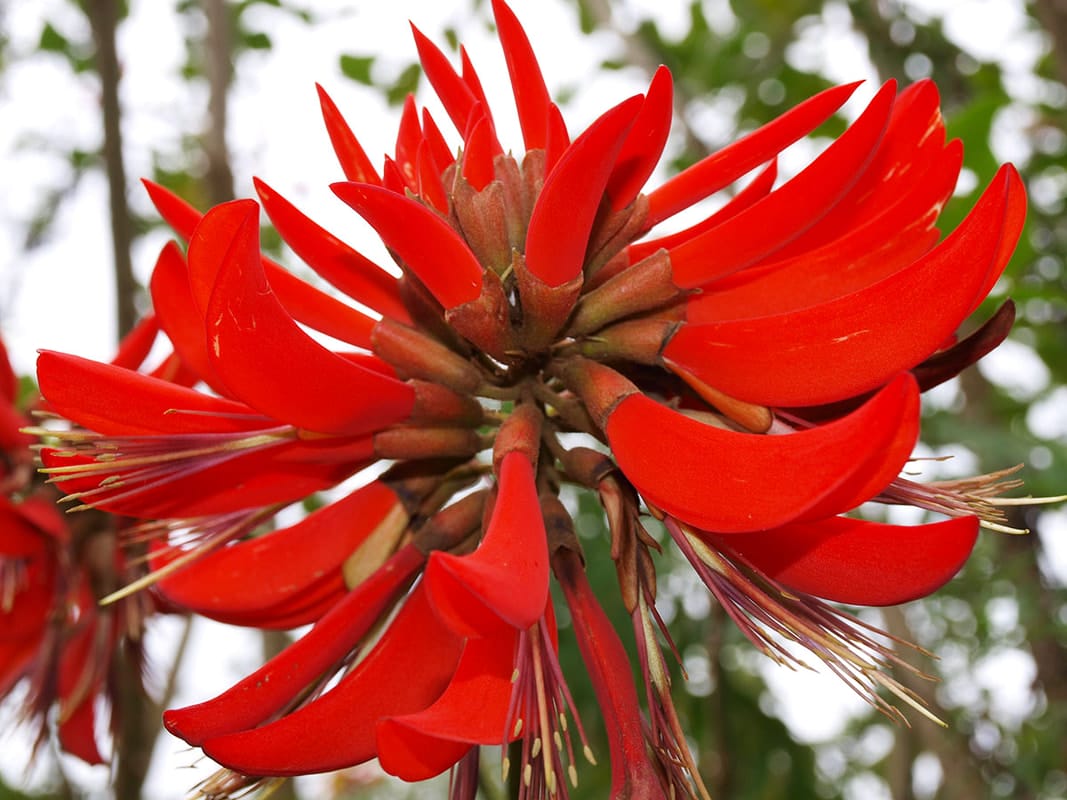Erythrina, Hai Tong Pi 海桐皮
Coral Bean Tree, Indian Coral TreeHai Tong Pi (TCM)
Paribhadra (Ayurveda)
Kaliyanamurukkan (Siddha)
Mkhal zho dkar po (Tibetan Medicine)
 Erythrina variegata
Erythrina variegataBlanco, M., Flora de Filipinas, ed. 3 (1877-1883)
 Erythrina variegata flower
Erythrina variegata flower(Photo by Sajith Erattupetta) (Wikimedia)
Botanical name:
Erythrina variegata L. var. orientalis (syn. Erythrina indica)
E. arborescens is also used in Sichuan, China and Tibet; E. suberosa is also used in Ayurveda.
Other plants supply this medicine in some parts of China (see Substitutes below).
Parts used:
Bark; Stem Bark is used in India
Temperature & Taste:
Neutral. Bitter, Pungent
Classification:
D. Clear Wind and Damp
Constituents:
Alkaloids: erysovine, erysotrine, erysodine, erythraline, erysopine, erysopitine, erysodicnone, crysonine, betaine, choline
Uses:
1. Clears Wind-Damp, Opens the Channels, Eases Pain: (TCM, Ayurveda)
-Wind-Damp painful obstruction of the muscles and joints
-Rheumatism, Gout
-Lower Back and Lower Limb pain and numbness
-Spasms in the limbs
-can be used for Hot or Cold conditions depending on the herbs it is combined with
2. Clears Damp, Promotes Urine: (TCM, Ayurveda)
-Edema and fluid swelling
-also for Damp-Heat Diarrhea and chronic Dysentery
3. Settles Wind, Stops Itching: (TCM, Ayurveda)
-itchy skin conditions, Scabies (used as a wash)
-used for skin diseases including Leprosy in Ayurveda
4. Clears Heat: (Ayurveda)
-Fever
-Bile and Liver diseases
5. Kills Worms:
-used for Worm in Ayurveda; Parasites in TCM
-dried water extract of the bark may be used
-Leaf juice (3 mls) is given in India
6. Externally:
-wash for Wind-Damp Joint pain and Muscle spasms
-as a wash or ointment for Itchy skin diseases and skin lesions
-as a gargle for Gum pain and Toothache
Dose:
Decoction: 6–15 grams (TCM); 12–24 grams in Ayurveda (API)
Of the Powder: 4–12 grams
Substitutes:
1. Zanthoxylum ailanthoides, Z. molle (Zhe Tong Pi) is used as this medicine in Eastern China. It is also used for Trauma and difficult Urination.
2. Kalopanax septernlobus (Chuan Tong Pi) is used as this medicine in Sichuan, Western China. It is also used for Trauma and Fractures.
3. Bombax rnalabarica bark (Mu Mian Pi) is used as this medicine in Southern China. It is also used for Irregular Uterine Bleeding, Gastritis and Gatrodsodenal Ulcers.
Main Combinations:
1. Chronic Wind-Damp Joint pain in the lower back and limbs:
i. Erythrina, Achyranthes Niu Xi, Notopterygium Qiang Huo
2. Inflammation and pain in the Lower Limbs:
i. Erythrina with Phellodendron Huang Bai, Atractylodes Cang Zhu
ii. Erythrina with Dioscorea hypoglauca Bi Xie, Akebia Mu Tong
3. Joint pain and Muscle spasm from Wind-Damp and Cold, use a wash of Erythrina with Cinnamon twig (Gui Zhi) and Tinospora Kuan Jin Teng
4. Itchy skin diseases, Eczema:
i. Erythrina is used with Cnidium She Chuang Zi.
ii. Erythrina with Phellodendron Huang Bai, Smilax Tu Fu Ling, Sophora Ku Shen
5. Worm, Erythrina Leaf juice (3 mls) with Turmeric or Honey is given in children. (India)
6. External oil for Nervous and Rheumatic diseases, Premna with Aegle, Oroxylum, Erythrina indica, Stereospermum, Withania, Boerhaavia, Tribulus, Solanum xanthocarpum, Solanum indicum, Sida cordifolia, boiled in Sesame oil for external application. (Ayurveda)
Major Formulas:
Cautions:
Generally Safe.
1. Caution in Yin or Blood deficiency and Lower back pain from Deficiency.
Main Preparations used:
Research
The Tetracyclic alkaloids (0.05% in the bark) have shown the following effects:1. Muscle relaxant
2. Sedative
3. Anti-inflammatory
4. Neuromuscular inhibition
5. Anticonvulsant
6. Smooth muscle relaxant
7. CNS depressant
8. Anti-microbial against Staph aureus and Mycobacterium smegmatis.
